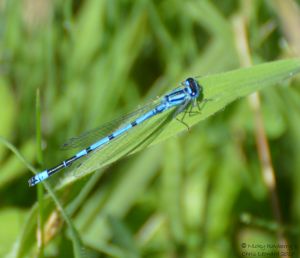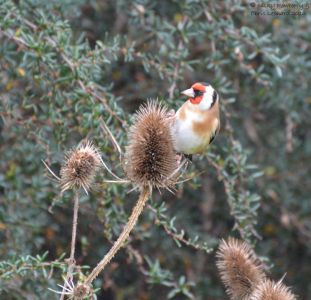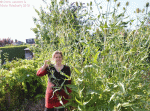The Big Garden Birdwatch weekend is here!
As usual the garden has been aflutter with birds in the days leading up to the Birdwatch, but come the day itself, everything went quiet! I had been dutifully keeping all the feeders topped up for the last couple of weeks, in the hope of establishing some kind of loyalty amongst the local bird populations. They may be loyal, but they are not very punctual, most refusing to do their turn in the allotted hour.
Fortunately some did eventually grace the garden with their presence; a total of 21 individuals of 7 species. So here’s the final tally:
- 11 House Sparrows
- 2 Blackcaps
- 2 Blackbirds
- 2 Blue Tits
- 2 Long-tailed Tits
- 1 Great Tit
- 1 Robin
I only managed to count 11 sparrows in one go, but I reckon there were a lot more lurking in the bushes, just taking it in turn to make an appearance. The goldfinch, wren, pigeons, dunnocks, coal tits and starlings, that have been seen in recent weeks, all got shy and refused to show (they were probably doing the conga in next door’s garden out of sight of me and my notebook).
 Having done the actual count, I thought it would be nice to take photos of all the species that had featured (give them their 15 minutes of fame). I could of course have counted and snapped at the same time, but wielding a pen and a camera simultaneously, just seemed like too much effort! Needless to say not all of the magnificent 7 chose to return for their photo op. The long-tailed tits were obliging, just too damn fast to get shots that did them justice – this was about as good as I could manage.
Having done the actual count, I thought it would be nice to take photos of all the species that had featured (give them their 15 minutes of fame). I could of course have counted and snapped at the same time, but wielding a pen and a camera simultaneously, just seemed like too much effort! Needless to say not all of the magnificent 7 chose to return for their photo op. The long-tailed tits were obliging, just too damn fast to get shots that did them justice – this was about as good as I could manage.
The blue tits are of course always photogenic and the sparrows squabbled to get themselves in the best shot.
I had seen both a male and a female blackcap during the count, but only the female returned to get her photo taken – eye to eye as it happens with the great tit.
 Since the birdwatch had got us in an avian frame of mind, we decided it was time to put up the new birdbox the other half had bought me for Christmas (no sparkly jewels for me!) New box duly installed on side of garage next to old one. We were really chuffed last year to get a family of Blue Tits in the old one (which got cleaned out today too while he was up the ladder), so fingers crossed they like the new des res (it’s not just a bird box, it’s an M&S birdbox!)
Since the birdwatch had got us in an avian frame of mind, we decided it was time to put up the new birdbox the other half had bought me for Christmas (no sparkly jewels for me!) New box duly installed on side of garage next to old one. We were really chuffed last year to get a family of Blue Tits in the old one (which got cleaned out today too while he was up the ladder), so fingers crossed they like the new des res (it’s not just a bird box, it’s an M&S birdbox!)
There’s still time to do a count for the Big Garden Birdwatch if you haven’t already. When I looked at their webpage just before posting this, they’d already had over 2 millions birds recorded by nearly 100,000 people. Why not join in? https://ww2.rspb.org.uk/discoverandenjoynature/discoverandlearn/birdwatch


























